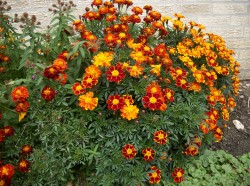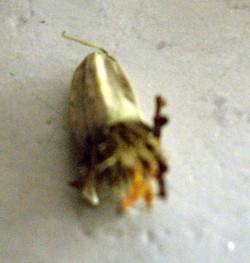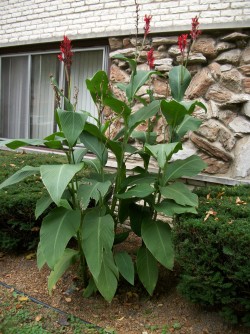Denver, New York and other parts of the country have already had their first brush with winter snow. We, in Chicago, on the other hand, have had a pretty easy time this fall. Gardeners are not disappointed.
In Chicago we’ve been enjoying a delightful — though all too short — fall. Trees and other seasonal plants have been resplendent in all their  beauty. We’re enjoying some spectacular displays this year – trees in our neighborhoods and flowers like of mums and other late-blooming flowers are dazzling us with all their glory – a reminder that the bitter winter ahead is only temporary. Some of the summer flowers – like marigolds – are still delivering gorgeous splashes of color in our condominium’s garden.
beauty. We’re enjoying some spectacular displays this year – trees in our neighborhoods and flowers like of mums and other late-blooming flowers are dazzling us with all their glory – a reminder that the bitter winter ahead is only temporary. Some of the summer flowers – like marigolds – are still delivering gorgeous splashes of color in our condominium’s garden.
If you’re interested in taking advantage of nature’s gifts, you’ll want to remember to get out now and gather seeds from the plants that you enjoy most for planting next summer. Why wait and buy the same seeds and plants from year to year when nature has so much to offer – free?
Where will your plants grow best?
It’s really easy. First, it’s important to recognize that city gardens have all kinds of variances – mini ecological systems that delight a wide variety of plants. Some spots are shadier than others, some are naturally drier than others. Your plants will tell you where they like to grow. Just watch where they thrive. Within a year or two you will be able to plan intelligently to maximize your efforts.
When you’re gathering think about where you want to grow the plant in your own landscape and look for plants that are now thriving in similar locations.
Throughout the growing season just pop off the dried seed pods left behind when the blooms die. It’s called dead-heading and something you should be doing throughout the season to stimulate continued flowering.
With that in mind, fall is the best time to get busy if you want your garden to thrive next summer.
Seeds
Some plants like marigolds reproduce by dropping seeds. As each flower fades and dies  off it leads a pod of seeds hidden amidst their foliage. Throughout the year by pinching off these pods, a gardener can easily ensure an abundance of new flowers. This is called dead-heading.
off it leads a pod of seeds hidden amidst their foliage. Throughout the year by pinching off these pods, a gardener can easily ensure an abundance of new flowers. This is called dead-heading.
My personal practice is to wait and watch until I see which plants I like the best and then as the pods start appearing, I pinch them off, open them and let the seeds dry thoroughly. I save them in an old cottage cheese container or baggie. In the spring I scatter them freely wherever I’d like new plants to grow. I personally prize the seeds this time of year because they have had a full season to develop to their fullest potential. 
Here you see what a mature marigold seed pod looks like. Inside are easily 30-50 seeds. I picked it the same day I photographed the marigolds above it.
Beyond that, leaving the plants grow right into the winter and letting them drop the seeds themselves will ensure a new crop the next summer as well.
Bulbs
Plants that grow from bulbs are another matter. Plant them the first year and then let them do their thing. During the year those bulbs will generally expand and multiply giving you an ever more spectacular display from year to year.
 But you do need to be careful. We have semi-topical Cannas that actually do very nicely in Chicago. The trick here is to watch where you plant them. They thrive in sunny spots and will disappoint if they are expected to grow where there’s too much shade. Unlike hardier bulbs, they do not do well if left in the frozen ground through the winter here in Chicago.
But you do need to be careful. We have semi-topical Cannas that actually do very nicely in Chicago. The trick here is to watch where you plant them. They thrive in sunny spots and will disappoint if they are expected to grow where there’s too much shade. Unlike hardier bulbs, they do not do well if left in the frozen ground through the winter here in Chicago.
Again, a little effort can save a ton of money from year to year. Let them grow right up to the first frost. And before the ground freezes. Dig up those bulbs – if you save the bulbs from the strongest plants you’ll be amazed first because you’ll have many more at the end of the year than you did when you first planted them and second by the quality of the plant next year. Just cut the bulbs from the stems and put those bulbs (they’ll look pretty ugly – but don’t worry) in a cool dry corner of your basement or garage and replant in the same spot and similar spots come spring.
Plants that take care of themselves
Don’t forget when planning to include the shrubs that love to show off while requiring very  little attention, like burning bushes. Many will withstand the harsh extremes of Chicago weather. Just make sure, when planting, to place them in the right corner of your yard and let them grow. They’ll delight you from year to year with very little effort on your part.
little attention, like burning bushes. Many will withstand the harsh extremes of Chicago weather. Just make sure, when planting, to place them in the right corner of your yard and let them grow. They’ll delight you from year to year with very little effort on your part.
Follow Nature’s Lead And Enjoy Spectacular City Gardens
Actually, gardeners know that if they pay attention to nature – and work with it – it’s easy to ensure spectacular splashes of color from year to year. In fact, it almost becomes a matter of managing and controlling the garden. Once you find the plants that thrive in your garden, the biggest task, to my way of thinking, is removing the plantlets that spring up
Do it on a dime
One of the best reasons for working with nature instead of doing annual shopping for plants at the beginning of each season is you will have plants that have proven themselves. They are plants that have shown that they adapt very well to Chicago’s many quirks. Trying to work with hot-house plants from year to year requires a great deal more attention to make sure that they can make the transition from a controlled environment to your backyard effortlessly. If you’re just getting started, never fear. In Chicago you can find garden exchanges and gardeners who really would like to share their abundance with others rather than discarding good viable plants.
Why fight it? Why spend tons of money on landscaping? And, why tolerate the drab concrete jungle when it takes so little effort to turn it into a paradise? Work with nature and enjoy success beyond your wildest expectations.
